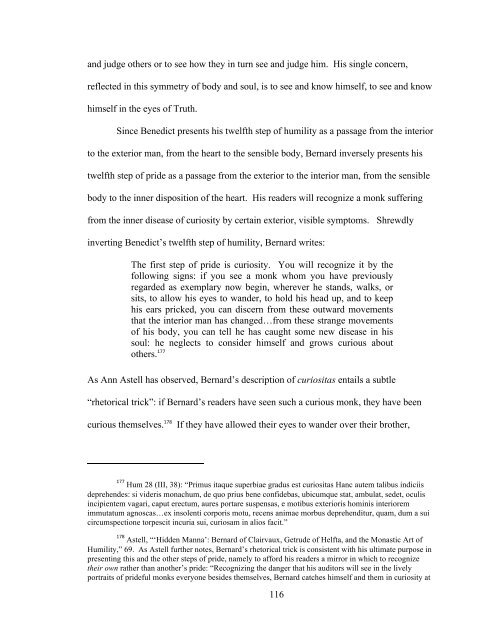MY BELOVED IS MINE AND I AM HIS: SELF-KNOWLEDGE IN THE ...
MY BELOVED IS MINE AND I AM HIS: SELF-KNOWLEDGE IN THE ...
MY BELOVED IS MINE AND I AM HIS: SELF-KNOWLEDGE IN THE ...
Create successful ePaper yourself
Turn your PDF publications into a flip-book with our unique Google optimized e-Paper software.
and judge others or to see how they in turn see and judge him. His single concern,<br />
reflected in this symmetry of body and soul, is to see and know himself, to see and know<br />
himself in the eyes of Truth.<br />
Since Benedict presents his twelfth step of humility as a passage from the interior<br />
to the exterior man, from the heart to the sensible body, Bernard inversely presents his<br />
twelfth step of pride as a passage from the exterior to the interior man, from the sensible<br />
body to the inner disposition of the heart. His readers will recognize a monk suffering<br />
from the inner disease of curiosity by certain exterior, visible symptoms. Shrewdly<br />
inverting Benedict’s twelfth step of humility, Bernard writes:<br />
The first step of pride is curiosity. You will recognize it by the<br />
following signs: if you see a monk whom you have previously<br />
regarded as exemplary now begin, wherever he stands, walks, or<br />
sits, to allow his eyes to wander, to hold his head up, and to keep<br />
his ears pricked, you can discern from these outward movements<br />
that the interior man has changed…from these strange movements<br />
of his body, you can tell he has caught some new disease in his<br />
soul: he neglects to consider himself and grows curious about<br />
others. 177<br />
As Ann Astell has observed, Bernard’s description of curiositas entails a subtle<br />
“rhetorical trick”: if Bernard’s readers have seen such a curious monk, they have been<br />
curious themselves. 178 If they have allowed their eyes to wander over their brother,<br />
177 Hum 28 (III, 38): “Primus itaque superbiae gradus est curiositas Hanc autem talibus indiciis<br />
deprehendes: si videris monachum, de quo prius bene confidebas, ubicumque stat, ambulat, sedet, oculis<br />
incipientem vagari, caput erectum, aures portare suspensas, e motibus exterioris hominis interiorem<br />
immutatum agnoscas…ex insolenti corporis motu, recens animae morbus deprehenditur, quam, dum a sui<br />
circumspectione torpescit incuria sui, curiosam in alios facit.”<br />
178 Astell, “‘Hidden Manna’: Bernard of Clairvaux, Getrude of Helfta, and the Monastic Art of<br />
Humility,” 69. As Astell further notes, Bernard’s rhetorical trick is consistent with his ultimate purpose in<br />
presenting this and the other steps of pride, namely to afford his readers a mirror in which to recognize<br />
their own rather than another’s pride: “Recognizing the danger that his auditors will see in the lively<br />
portraits of prideful monks everyone besides themselves, Bernard catches himself and them in curiosity at<br />
116
















